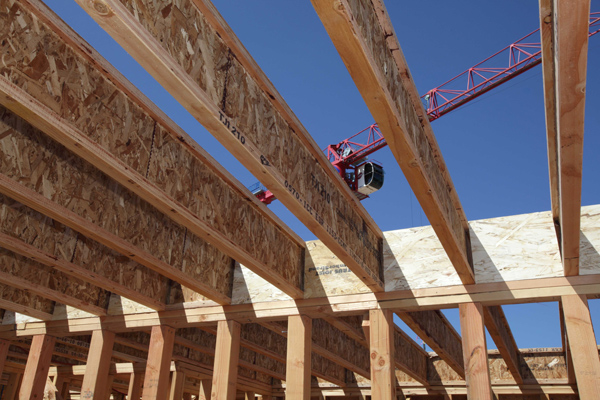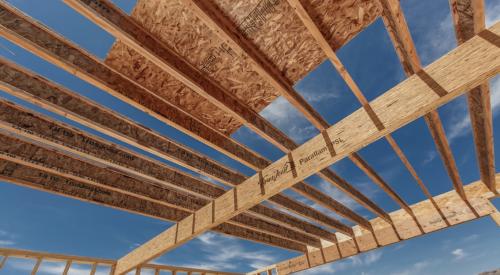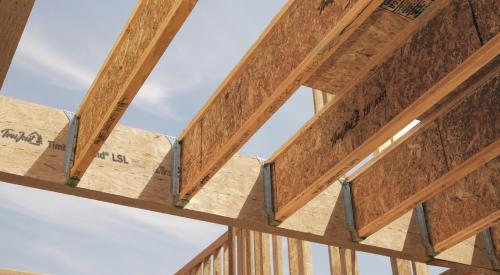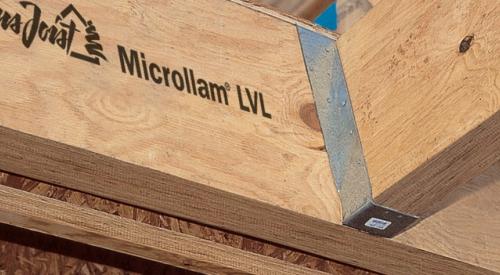When it comes to the floor system, builders often think about code compliance and structural performance. But what about the intangible part—how the floor feels? It’s a consideration that, if ignored, could tarnish your company’s reputation.
Many different factors within and above the framing system can influence a homeowner’s perception of the floor system. Too much vibration and bounce can mean discomfort, rattling dishes, and other problems down the road. Beyond meeting the code, there are a series of design decisions and installation techniques that, when planned carefully, can dramatically improve occupant comfort and accent a builder’s offering.
Problem Areas
Here are a few conditions that may lead to homeowner concerns – even if the floor meets code strength and deflection requirements.
- Long spans next to short spans: In a room in which an area of long span joists occurs next to short span joists, the occupant may perceive the floor to be more solid in the areas with the short spans. Shifts to open-concept floor plans have increased the need for long spans and subsequently increased the probability of concerns related to changes in span length between adjacent joists.
- Long spans combined with higher dead loads: In multifamily projects, open floor plans combined with concrete toppings or other heavy finishes or furnishings can be another trouble spot.
- Joists used to their maximum spans: When reaching the maximum strength or deflection limit for a certain joist, the floor system may be economical and strong enough, but it also may undergo more deflection or bounce than expected by the homeowner.
- Kitchen islands: Kitchen islands have become a standard feature in nearly any size home and are often as narrow as 2 feet and 6 to 8 feet long. Frequently these narrow islands run parallel to the floor framing and often straddle a single joist. As a result, a joist near the island that is stepped on may have minimal deflection but can still result in visible movement on the island (rattling dishes and rippling drinks).
- Floor finishes: Unlike carpet and padding, hardwood flooring allows the physical impact and audible noise of each step to be noticeable, resulting in a perception of reduced performance.
Designing Floors for Desired Performance
While it would be ideal to always specify a very stiff floor with minimal deflection, there are economic considerations that may make this approach unreasonable.
Weyerhaeuser has developed a proprietary system called TJ-ProTM Rating that predicts floor performance based on assembly inputs and assigns a rating value. TJ-Pro Ratings help specifiers determine a floor system design that offers a balance between desired performance and cost. Builders can dial in floor feel by evaluating the combined effects of TJI joist series, depth and spacing along with other system parameters, such as deck thickness, support conditions and ceiling finish.
The rating system can be targeted to different client preferences, or even to individual areas of the floor, taking into consideration how different rooms will be used and occupied.
Consider a scenario in which 16-foot-long joists under a kitchen are adjacent to 20-foot-long joists at a bump out for an eating nook. Simply meeting code requirements would allow the longer joists to deflect 25% more than the shorter joists. In attempting to address this potential performance concern without TJ-Pro Rating, the most common (and costly) approach would be to double the longer joists to achieve the equivalent stiffness of the shorter joists.
Fortunately, the TJ-Pro Rating system can compare several alternatives to achieve a desired floor performance and capture the feel of the floor, not just deflection. As a result, more economical solutions can be devised rather than doubling the joists in a floor system.
For more information on TJ-Pro Ratings, visit http://www.woodbywy.com/software/tj-pro-rating-system/.












